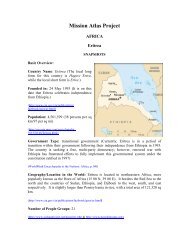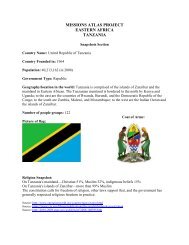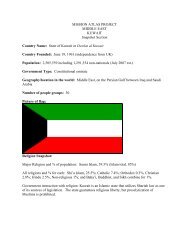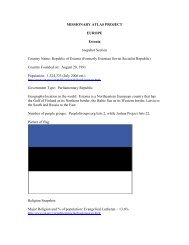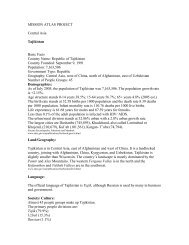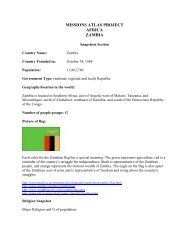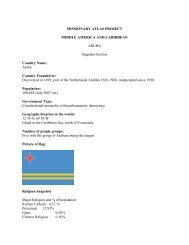Lebanon Profile.pdf - WorldMap
Lebanon Profile.pdf - WorldMap
Lebanon Profile.pdf - WorldMap
Create successful ePaper yourself
Turn your PDF publications into a flip-book with our unique Google optimized e-Paper software.
Early Times<strong>Lebanon</strong>'s long and often turbulent history reaches back to the dawn of civilization peoples haveoccupied the coastal plain and the Bekáa Valley since the Old Stone Age, or Paleolithic, roughly7,000 to 9,000 years ago. Several waves of people, mostly Semites, entered the region from theArabian Peninsula. By 2800 BC, cedar timber from Byblos was being traded for metals andivory from Egypt. They established cities at Beirut, Byblos, Tyre, Sidon, and Baalbek.About 2200 BC, Semitic Amorites arrived from Arabia and Syria. From the westernAmorites, the Canaanites evolved along the full length of the eastern shore of the MediterraneanSea. During succeeding centuries the Canaanites developed the most favored coastal villages intocelebrated city-states: Tripoli, Byblos, Beirut, Sidon, and Tyre.By about 1100 BC the northern Canaanites became known as Phoenicians. The namecame from the Greek word phoinos, meaning “red,” a reference to the unique purple dye thePhoenicians produced from murex seashells. The Phoenicians developed 22-letter Phoenicianalphabet that they spread throughout the region. This alphabet was one of the earliest.The Phoenicians mastered the art of navigation and they dominated the MediterraneanSea trade for 400 to 450 years. They established cities at Beirut, Byblos, Tyre, Sidon, andBaalbek and influenced surrounding peoples for centuries. Phoenicians surrendered to andadjusted to successive conquerors: Assyrians in 867 BC; Babylonians in the 590s BC; Persians in538 BC; and Greeks under Alexander the Great in 333 BC. Phoenician trade declined with Greekcompetition after the 5th century BC.After this succession of different rulers, <strong>Lebanon</strong> became part of the Roman Empire in 64BC. The Romans began an imperial rule over the area that continued under the ByzantineEmpire (Eastern Roman Empire) for 573 years. Under Rome, Phoenicians prospered again asthey rebuilt fleets and made great cultural progress.Aramaic replaced Phoenician as the main language and by the 4th century Christianitywas firmly established. During the early years of the Christian era, when theological differencesbred numerous break-away sects, <strong>Lebanon</strong> became a refuge for religious minorities fleeingpersecution.In the 7th century, the Christian sect that was later to become the Maronite church settledin the northern districts of the Lebanese Mountains to avoid conversion to Islam. The Arabs,inspired by the teachings of the Prophet Mohammed, had converted most of the region to Islam.The geographical inaccessibility that made <strong>Lebanon</strong> attractive as a religious refuge also appealedto Muslims. Shiites found a haven in <strong>Lebanon</strong> during the 9th century and the Druzes in the 11thcentury. The country allowed the different religious groups to exist, but this openness hamperedunity of the country as a whole.The Sidonians grew wealthy with their invention of blown glass. The Roman influenceon the regional culture can be clearly seen in the majestic ruins of Roman temples in <strong>Lebanon</strong>,particularly in Baalbek. Beirut‟s School of law became famous while the region was under




